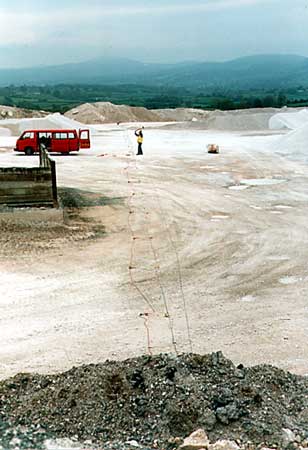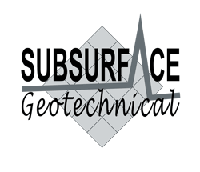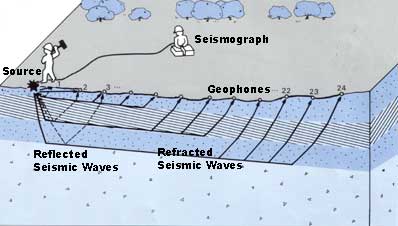


Seismic refraction is a geophysical method used for investigating subsurface ground conditions by utilising surface-sourced seismic waves. Data acquired on site is computer processed and interpreted to produce models of the seismic velocity and layer thickness of the subsurface ground structure. The method is commonly used for measuring the thickness of overburden in areas where bedrock is at depth, and assessing ripability parameters
Pulses of low frequency seismic energy are emitted by a seismic source such as a hammer-plate, weight drop or buffalo gun. The type of source is dependant on local ground conditions and required depth penetration. Explosives are best for deeper applications but are constrained by environmental regulations.
The seismic waves propagate downward through the ground until they are reflected or refracted off subsurface layers. Refracted waves are detected by arrays of 24 or 48 geophones spaced at regular intervals of 1 - 10 metres, depending on the desired depth penetration of the survey. Sources are positioned at each end of the geophone array to produce forward and reverse wave arrivals along the array. Additional sources may be used at intermediate or off-line positions for full coverage at all geophone positions.
Geophones output data as time traces which are compiled and processed by the seismograph. The basic components of a seismic trace are the direct wave, the reflected wave and the critically refracted wave. Wave refraction occurs at interfaces in the ground where the seismic velocity of the lower layer is greater than the velocity of the overlying layer. This condition normally applies in near surface site investigations where soil or fill overlies bedrock.

At geophone positions close to the seismic source, the first seismic wave arrivals are direct waves. However, beyond a critical distance from the source, the first arrivals change to refracted waves due to the faster relative velocity of the refracted waves. Interpretation procedures involve the accurate measurement of first arrivals from the time traces recorded at each geophone position.
Interpretation techniques are applied to the first arrival times to calculate the seismic velocities of the layers and the depths of individual refracting interfaces. The interfaces are correlated with real physical boundaries in the ground, such as the soil-bedrock interface and other lithological boundaries, to produce a model of the subsurface ground structure. The final interpretation is presented in a format that is easily understood by engineers.
Measures Bedrock Depth & Overburden Thickness
Determines Rippability Parameters
Investigates Pipeline Routes
Locates Geological Structures
Evaluates Sand & Gravel Deposits
Defines Ancient Landfill Sites